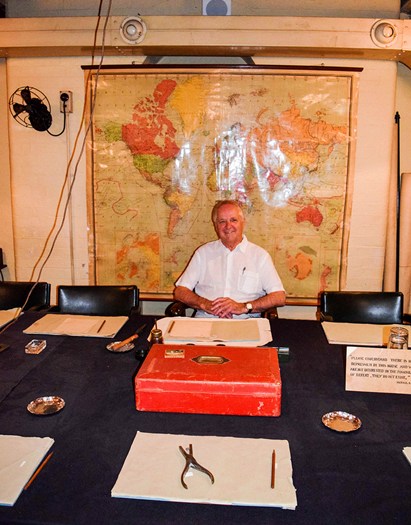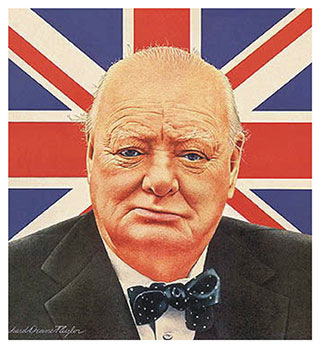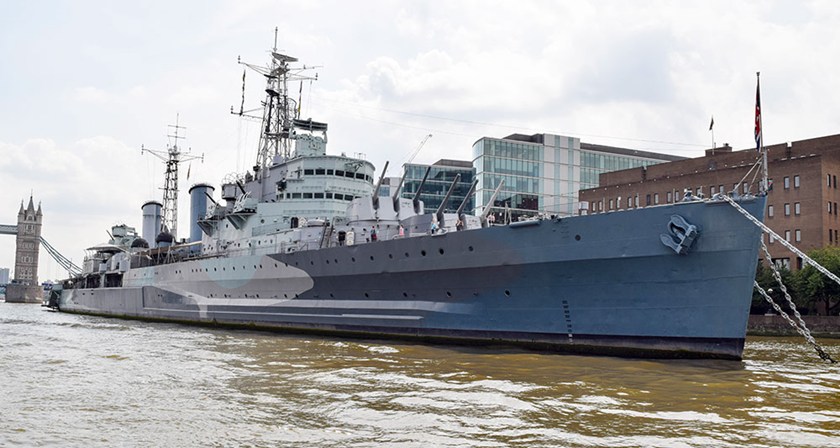LONDON - The man with the snow-white hair and reddish face greets us with a hearty welcome at the entrance to the Cabinet War Rooms, one of Britain’s best museums.
Phil Reed, the curator of this and several other museums that make up Britain’s impressive Imperial War Museums, leads us through a throng of early-morning visitors to a steel door with a mannequin soldier dressed in World War II battle gear standing guard.
The heavy door creaks as the congenial Reed swings it open and a swoosh of stale air brushes against our cheeks as we enter.
“Welcome to the War Cabinet Room,” says the curator of a museum that proves that good things come in small packages.


Above: Editor-in-Chief Marc Atchison gets to sit in the chair occupied by Churchill throughout most of World War II.
“This is where Sir Winston Churchill and his Cabinet would meet and make the biggest decisions of the war,” says Reed, who probably knows more about Churchill than any person alive.
Envious tourists watch through a picture window as Reed spends time telling me what life was like in this Cabinet bunker where Churchill and his closest advisers, both military and political, lived and worked while Nazi bombs rained down on London during the bleakest moments of World War II.
“There were some heated moments in this room because Churchill did not always agree with his advisers and would take them to task on just about every issue,” Reed tells me.
The bunker, located in the basement of a building in Whitehall, close to the Prime Minister’s residence at No. 10 Downing Street, was discovered intact many years after the war ended. The occupants simply put on their hats and coats, turned off the lights and left the room on the day the war ended.
So, what you see today is exactly what the room looked like back then, right down to the bed Churchill slept in.
Reed leads us to a chair at the head of the Cabinet Room table where Churchill sat during those tempestuous meetings and shows me some deep scars carved into the arms.
“Churchill wore a ring and when the debates in here got very heated, he would scratch the ring against the arm and that left these deep marks,” says Reed, who says the marks on the opposite arm of the chair were created by Churchill’s fingernails.
Reed then insists that I sit in the great man’s chair. “Go ahead, he won’t mind,” laughs the curator.
My spine tingles with excitement and my pulse quickens as I slowly lower myself into the seat of power. I insist Reed take a picture and suddenly I have an urge to smoke a giant cigar. The tourists watching on the opposite side of the glass are now truly green with envy.
Reed is a busy man and apologizes for having to leave me, but has a previous appointment to be kept at one of the other museums under his watch – HMS Belfast. But he insists I continue my tour of the War Rooms.
“And make sure you spend lots of time in our Churchill Museum,” says Reed before disappearing down the dark wartime corridor reinforced with steel beams.
So after I walk through the entire bunker, stopping to admire the separate bedrooms where Churchill and his wife slept during the Blitz, the cramped quarters where military personnel communicated with the world above, and relish in all the World War II memorabilia on display, I visit the museum dedicated to one of the world’s greatest leaders.

Above: The HMS Belfast played a huge role in World War II and is now an anchored museum on the Thames River.
The well-designed and informative museum chronicles every period of Churchill’s life, from his birth, his Boer War experiences, his incredible life in politics and, of course, his death, which brought the world to tears.
Letters exchanged between Churchill and his beloved wife Clementine (they had pet names for each other, Kat for her and Pug for him), some of his earliest paintings – painting was a therapeutic hobby for Churchill during tense times – and the lavish clothes he wore give you real insight into one of history’s most complex characters.
There’s also an interactive model of Churchill’s country estate, Chartwell in Kent, where he entertained his many friends and supporters during World War II and his turbulent years as Britian’s prime minister.
As I leave the bunker and step back into a sun-drenched London day, the lineup at the entrance to the Cabinet War Rooms stretches half a block and I hear one woman wonder “how long the wait will be?”
No matter the wait, the Cabinet War Rooms and Churchill Museum well worth it.
Information
To get more information on the Cabinet War Rooms and all the other Imperial War Museums in Great Britain, go to
www.iwm.org.uk / For more on travelling to Great Britain, go to
www.visitbritain.com / Air Canada, British Airways and a host of charter airlines offer daily flights to England from Toronto, Ottawa, Montreal, Calgary and Vancouver
About the Author
Marc Atchison is a veteran journalist and a seasoned traveller with more than 20 years of travel writing experience. As the former Travel Editor of the Toronto Star, Canada's largest newspaper, and now Editor-in-Chief and Senior Writer for TraveLife magazine (Canada) and travelife.ca, Marc has been to over 100 countries in the world. Japan is one of his favorite destinations and he's been there on numerous occasions.